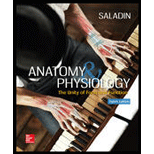
Concept explainers
Introduction:
Structures that are specialized for the detection of a stimulus, such as pain and heat, are referred to as a sensory receptor. Such receptors can either be real sense organs or simple nerve endings. Sense organs are involved in the transmission of data (through neurons) to the specific place inside the nervous system. Such sense organs may range from simple microscopic structures like dendrites to complex structures like ear and eye. Receptors can be classified into three categories based on the stimulus origin, modality, and its location in the body. The classification of taste receptors: (i) based on the modality of the stimulus: chemoreceptors; (ii) based on the stimulus origin: exteroceptors; and (iii) based on the location of receptors in the body: specific senses.
Want to see the full answer?
Check out a sample textbook solution
Chapter 16 Solutions
Anatomy & Physiology: The Unity of Form and Function
- What is the pathway of taste?arrow_forwardDefine what are Taste buds in humans ? Explain with diagram ?arrow_forwardDo gustatory taste cells have BOTH chemoreceptors and mechanoreceptors? The chemoreceptors are responsible for receiving the signals that the saliva molecules send via action potentials, but there are also hair cells attached to the taste cells that detect movement?arrow_forward
- Connoisseurs can recognize many varieties of cheese or wine by “tasting.” How can they do so when there are only a few types of taste receptors?arrow_forwardHow do the olfactory bulbs of sheep compare to the olfactory bulbs of humans?arrow_forwardWhat are the olfactory gland and Bowman's gland? and what are their functions ? Explain with pictures.arrow_forward
- How many different taste molecules do taste cells each detect? a. one b. five c. ten d. It depends on the spot on the tongue.arrow_forwardWhat are olfactory receptors, olfactory sensory neurons, olfactory bulbs, and olfactory cortex?arrow_forwardWhat are the five primary tastes? Describe how each typeof tastant causes depolarization of a taste cell.arrow_forward
 Human Biology (MindTap Course List)BiologyISBN:9781305112100Author:Cecie Starr, Beverly McMillanPublisher:Cengage Learning
Human Biology (MindTap Course List)BiologyISBN:9781305112100Author:Cecie Starr, Beverly McMillanPublisher:Cengage Learning
